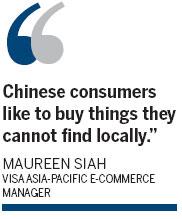Chinese consumers represented the largest Asia-Pacific group of online shoppers buying from overseas websites in the past year, with a preference for clothing and shoes, a survey has found.
 Thirty-seven percent of respondents from the mainland have made purchases on overseas websites in the past 12 months, compared with an average of 32 percent in the Asia-Pacific region, according to the 2010 Visa E-commerce Consumers Survey, which was released on Tuesday in Beijing.
Thirty-seven percent of respondents from the mainland have made purchases on overseas websites in the past 12 months, compared with an average of 32 percent in the Asia-Pacific region, according to the 2010 Visa E-commerce Consumers Survey, which was released on Tuesday in Beijing.
"Chinese consumers like to buy things they cannot find locally," said Maureen Siah, e-commerce manager of Visa Asia-Pacific. Most of the shoppers are female, and UK and US websites are the most popular because of the language recognition in China, she said.
In addition to online shopping, education and travel services contribute to much of the spending on the international websites. Small- and medium-sized enterprises also use online channels to buy products not locally available, said Vivian Zhao, chief representative of the Visa International Beijing Office.
Visa interviewed 505 people age 18 and older in the mainland from August to September.
In the past 12 months, 98 percent of them made purchases from Chinese or foreign websites at least once, compared with 80 percent in Malaysia and 87 percent in the Asia-Pacific region.
Internet users in Taiwan are the biggest spenders, averaging $4,041 in online spending, compared with consumers in the mainland spending $2,557.
Travel, including airfares, accommodation and fees, and electronics were among the largest business categories in online spending. Convenience is a major factor. "To be able to shop at any time is the prime reason," said Siah. Consumers also look online to find and compare products or to compare prices."
About 76 percent of mainland respondents have paid bills online in the past 12 months. Most of those who did not are considering doing so in the next six months, the survey found.
Dong Yu, mother of a 1-year-old daughter, goes online every night after putting her child to bed. She enjoys being able to shop without having to leave her daughter. Dong has bought books, clothing, and even food. "Online shopping has a lot of options and saves money," she said.
Though she is fascinated by the products on overseas websites, she has not made purchases from them because of shipping and payment difficulties.
Su Huiye, an analyst with iResearch, a Shanghai-based consulting firm, said that she believes cross-border online buying makes up a small part of the market because of difficulties with duties, shipping, and payment - iResearch has not analyzed this market.
Su said that many Chinese consumers pay third parties overseas to make online purchases and then send the products by mail. These most often involve luxury products that are either unavailable at stores in China or are lower priced before import taxes, she added.
Chinese Internet users now number 420 million, the most of any nation. By 2012, global e-commerce revenue is expected to be worth $183.9 billion, Internet retailers' news site emarketer.com estimated in 2008. E-commerce in China will grow to $94 billion in revenue in 2012 and $159 billion by 2015, according to Forrestor Research Inc.





